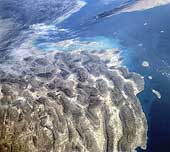|
COMETS EARTH JUPITER KUIPER BELT MARS MERCURY METEORITES NEPTUNE OORT CLOUD PLUTO SATURN SOLAR SYSTEM SPACE SUN URANUS VENUS ORDER PRINTS
PHOTO CATEGORIES SCIENCEVIEWS AMERICAN INDIAN AMPHIBIANS BIRDS BUGS FINE ART FOSSILS THE ISLANDS HISTORICAL PHOTOS MAMMALS OTHER PARKS PLANTS RELIGIOUS REPTILES SCIENCEVIEWS PRINTS
|
Related Document
Download Options
One of the most spectacular examples of anticlinal fold structures lie on the north shore of the Strait of Homuz in the Persian Gulf. Located near the important city of Bandar Abbas, these folds form the foothills of the Zagros Mountains, which run north-northwesterly through Iran. The folds were formed when the Arabian shield collided with the western Asian continental mass about 4 to 10 million years ago. Subduction still continues slightly further east, beneath Baluchistan, but is inactive in the Gulf itself. Although not obvious in the photograph, the shortening expressed by the folds is accompanied by extensive thrusting on the easterly dipping planes. All the deformation is geologically young; the folded sediments are Paleogen and Neogen. Simple anticlinal structures are well know as classic traps for hydrocarbons, and some producing wells are located in the area. The other features that are prominent in this photograph are the dark circular patches. These represent the surface expression of salt domes that have risen diapirically from the Cambrian Hormuz salt horizon through the younger sediments to reach the surface. Only in a hot arid environment such as that of the Gulf can the soluble salt escape rapid erosion. Salt domes also are frequently favorable sites for trapping hydrocarbons. |
